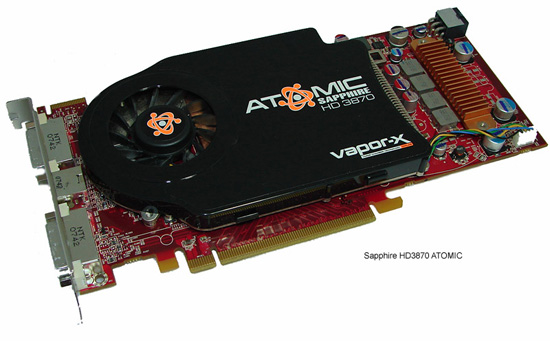Video Card
To some degree, the onboard graphics capabilities of the GF8200 and 780G would have sufficed for the majority of our needs. However, I like to play RTS or Racing/Flight Simulation games when time is available (wishful thinking actually) and my daughter is a big Sims 2, Rollercoaster Tycoon 3, and World of WarCraft fan. The capabilities of the 780G and GF8200 allow these games to perform reasonably well in resolutions up to 1280x1024 depending on quality settings, but we wanted to stick with the native 1920x1200 LCD resolution where possible so a discrete card is mandatory.
Since the games we play are not as graphically demanding as current FPS titles, we have some latitude in our selections. The first GPU that popped into my mind is NVIDIA's 9600GT. This chipset offers excellent performance for the price and has the HD display output capabilities we both need. The AMD HD 3850 was also a logical choice, especially with the budgetary requirements. However, not being logical at times can pay off. Considering the fact that I would like to get a good two years out of our GPU selection, it was time to move up market for something a little more powerful but a choice that would not break the bank.
I might have OCD, but in my experiences, keeping the same chipset manufacturer for both the motherboard and GPU seems to reduce the number of variables to diagnose when something goes wrong. In addition, at least subjectively, performance always seems a little better if it is an NVIDIA GPU on a NVIDIA board and the same with AMD.
With that thinking in mind, I decided to go for an HD 3870 card for my 780G machine. We have used the MSI, ASUS, and Gigabyte cards extensively in the labs and any one of them is an excellent choice. At any time, you can find several HD 3870 cards on sale for $149~$159 from various manufacturers. Knowing how cramped our case is and subject to increased thermals with our component loads, I decided on the Sapphire Toxic Radeon HD 3870 card as it runs about 5C cooler than other cards and it features a single-slot cooling design that is a requirement. The price of $159.99 after rebate was a little higher than the budget allowed, but by this time you have figured out the budget is flexible - at least until the Visa bill arrives.

For the GF8200 board in my daughter's system, I really debated whether to go the 9600 GT or 8800GS route, but knowing Spore and Sims 3 is on the horizon it appeared a little more power would provide some safety. So I decided on the 8800GT 512MB and like the AMD cards, there are numerous cards on sale at various times ranging from $150~$170 range. In the end, it came down to the MSI NX8800GT 512M OC at $159.99 or the Zotac 8800GT AMP! at $154.99 after rebates. The MSI card runs the core GPU clock at 660MHz and the Zotac at 700MHz, both guaranteed clocks above the 600MHz standard, which is nice to know that the supplier is promising an overclock without repercussions. Besides the slightly better price, the Zotac card had one large advantage: a single-slot cooler design, which is perfect for our uATX case.
I have to say I am very impressed with both video cards, from not only a design viewpoint but also looking at performance in our primary applications. However, the games I play benefit greatly from anti-aliasing and the HD 3870 suffers in this area when compared to the 8800GT. I knew that going in and it was the primary reason I wanted the GF8200/8800GT combination. I simply could have bought another 8800GT from Zotac and used it on the AMD board without problems, but between the OCD and balancing funds to each competitor, I decided to let my fondness for music make the decision. I will explain why in the audio section.
When it comes right down to it, the HD 3870 even with AA/AF enabled still provides very good performance for my needs. In addition, I still think AMD has a slight edge in Vista driver compatibility and desktop screen quality after comparing the two systems. Zotac includes an extensive accessory package along with a solid design that just gives you a secure feeling about the product and that the company backing it knows what the customer wants. The Sapphire package and product design also gives you that same sense of security and the card just looks right in the system, what little of it you can see.










33 Comments
View All Comments
JarredWalton - Wednesday, May 28, 2008 - link
You might want to do a bit more http://en.wikipedia.org/wiki/MicroATX">research. Just as all ATX boards aren't identical in size, there is some leeway in how big a micro-ATX board can be. Maximum size is 9.6" x 9.6", but they can be much smaller than that as well.While the correct abbreviation is µATX, mATX and uATX are synonyms that are equally valid in our modern PC vernacular. (Gasp! You mean Newegg is wrong!? Yup. It happens. Or you could consider it a mere difference of opinion, where Newegg is trying to redefine uATX to mean something other than mATX.)
DXRick - Thursday, May 29, 2008 - link
Thanks. Sorry for being stupid.FireTech - Tuesday, May 27, 2008 - link
A very interesting 'article' Gary, with insight into the world of a reviewer but nicely balanced with the requirements of the typical cash conscious geek/husband/parent!I'm certainly looking forward to part two.